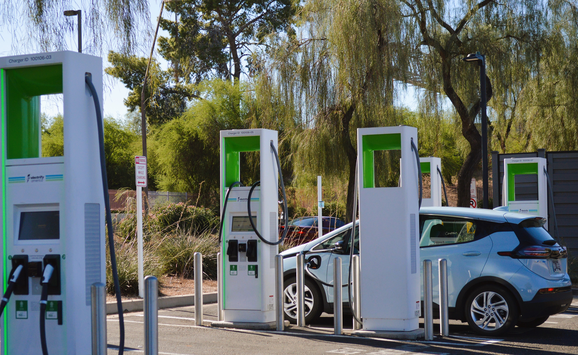Vehicle-to-grid programs offer school districts an opportunity to earn revenue by reinjecting electricity from fully charged electric school buses back into the electric grid. How good of a deal are these programs for school districts?
School districts that seek to reduce their environmental impact have looked to electrify their school bus fleets as a solution. Transitions from diesel to electric fleets have been supported by federal and state-level programs, such as the Clean School Bus Program, a $5-billion fund administered by the US Environmental Protection Agency. This program has financially supported school districts across the country with purchases of electric school buses and the charging stations needed to refuel them.
Federal and state financial support is a cornerstone of electric school bus adoption, given that the economics of decarbonizing a vehicle fleet can be particularly challenging without subsidies. However, school districts that are transitioning to electric school buses have an opportunity to earn revenue from an alternative source: participation in vehicle-to-grid (V2G) programs. These programs pay operators of electric vehicles to store electricity in the vehicle batteries and then reinject that electricity into the electric grid when demand for power is high (e.g., during the summer, when demand often peaks) or when electricity generators are producing large amounts of pollution. The reinjection of this electricity thereby helps reduce the overall cost of operating the grid. Batteries also can provide benefits to the grid beyond the direct supply of power, such as helping manage energy fluctuations and voltage levels, which confers value to grid operators and electricity customers.
V2G programs for electric school buses seem promising, given the unique combination of the large batteries in buses, predictable schedule of use, and overlap in many places of school summer breaks with higher energy demand on the grid. But even though a slew of social benefits and private benefits are expected from participation in V2G programs, these programs are not yet the status quo for school districts that seek to electrify, and questions remain about the net benefits of participation for school districts. So, to what extent can V2G programs financially benefit school districts, and could the financial benefits help overcome some of the economic challenges involved in the electrification of school bus fleets?
What’s the Potential Benefit for School Districts?
Incentives that utilities offer participants in V2G programs can take many forms, including up-front lump-sum payments, volumetric payments per kilowatt-hour of electricity that is reinjected into the grid, a mix of lump-sum and volumetric payments, and other alternative solutions. A handful of utilities across the country currently are providing these types of programs in pilot form for school bus operators.
For school districts that are incorporating potential revenue streams from V2G programs into decisions about fleet electrification, identifying the magnitude of these potential net benefits will be key for optimal decisionmaking. These benefits depend on the following factors:
How much does a fast charger cost when it’s compatible with a V2G program, versus a standard slow charger?
A V2G-enabled fast charger is significantly more expensive than a standard slow charger that is not compatible with a V2G program. (The latter generally would serve a school district well, because school buses can slowly recharge overnight.) The cost difference between these two kinds of chargers easily could exceed $100,000 per charger, especially when one considers the associated infrastructure upgrades that are required to accommodate the larger amount of electricity that is necessary to service V2G-enabled fast chargers.
How much do school districts pay to recharge bus batteries?
School districts may benefit from charging buses during times of day with low, off-peak pricing and then turning a profit by reinjecting electricity back into the grid during times of day when prices are higher; however, many school districts also will face demand charges, which are fees charged to customers based on their maximum electricity demand or power usage during a pre-specified period (e.g., a given hour). These charges could further complicate the calculation of benefits.

How much are school districts paid per kilowatt-hour of electricity that is injected into the grid, and how large is the up-front bonus that districts receive for participating in V2G programs?
The amount a school district is paid for participating in a V2G program (both as an up-front bonus and for injections of electricity into the grid) and the cost of charging buses are significant factors in the calculation of whether participation will result in revenues or losses for a given school district.
In sum, the private benefits from participation will vary significantly depending on the structure of the V2G program and the underlying electricity pricing plans (also known as electricity tariffs) that the school district faces.
Case Study: NV Energy’s Pilot Program
To examine the factors that determine the financial benefits for school districts, we conducted a case study for a pilot V2G program hosted by NV Energy in Nevada and compared the operational benefits (i.e., the amount paid to school districts for injections of electricity) with the operational expenses (i.e., the amount school districts pay to recharge buses).
Due to the lack of public information about the cost of charging infrastructure, we did not attempt to calculate the total private benefits and costs of participation in the program over the lifetime of this participation, which would take into account the extra costs associated with a more expensive V2G-enabled charger. To simplify the analysis, we looked at charging and the injection of electricity back into the grid only during the summer. This simplification allowed us to assume that school buses are parked and plugged in at all times; the buses recharge when electricity prices are lowest and inject electricity into the grid at the most optimal moments of a day.
Underlying Electricity Pricing Plans
The electricity pricing plan that applies to a school bus operator that’s looking to electrify a fleet of buses depends on the operator’s electricity demand; in turn, this demand is affected by the number of vehicles in the fleet, the size of the vehicle batteries, and the speed of the vehicle chargers. For this analysis, we assumed that the example school district has a 20-vehicle fleet with 220-kilowatt-hour batteries in each bus and a 60-kilowatt fast charger for each bus.
In the pricing plan that NV Energy uses during the summer, our example school district faces lower off-peak prices, including a demand charge of about $7 per kilowatt and a volumetric rate of about $0.14 per kilowatt-hour. Because the district has an eight-hour off-peak period, we assumed that buses charge overnight as slowly as possible, which results in a monthly bill of approximately $13,000.
Payments for Injections of Electricity
The price that the district receives for each kilowatt-hour that is injected into the grid is based on the cost to the system of producing electricity, which varies by hour depending on the conditions of the grid. Specifically, NV Energy pays one of two prices as determined by these conditions: either the cost of generating an additional unit of electricity in a given hour, or the average hourly load aggregation point price published by NV Energy—whichever price is lower. To facilitate this program, NV Energy injects electricity from school buses back into the grid during the times of the day when the price of electricity is highest. According to our estimate, the fleet could make approximately $6,700 per month if prices in summer 2025 reflect the load aggregation point prices from summer 2023.
Putting the Benefits and Costs Together
What does all this mean for school districts that are thinking about participating in the pilot program? Our analysis reveals the importance of comparing the rate structures that a school district could anticipate for charging electric school buses with the prices paid for injections of electricity into the grid. In our example with the NV Energy pilot, participation unfortunately seems to be a losing proposition from an operational perspective; net losses are estimated to be approximately $6,300 per month. The fleet in our example would lose almost $19,000 over the course of the summer by participating in the program.
So, why would a school district want to participate in this or any other V2G program? One answer is that V2G programs (including the NV Energy pilot) commonly provide substantial up-front incentives that, under certain conditions, can overcome operational losses from participation. For example, NV Energy pays for charging stations and includes an up-front bonus payment that can exceed $130,000 per bus. (The payment depends on the size of the battery in the bus.) If a school district lacks federal support for an electric school bus or charging station, a bonus from a utility could appear very beneficial; the bonus might enable the school district to transition to an electric fleet much more easily.
However, a variety of factors determine whether this up-front bonus exceeds the fixed and variable costs associated with participation in a V2G program. Because we do not have a good public source of data to identify the costs that are associated with V2G-enabled chargers, our analysis does not consider the total lifetime costs and benefits of V2G programs for school bus operators and how participation in these programs may support or hinder the economic proposition of going electric.
Benefits and Costs—Not Just for Society, but Also for School Districts
When proposing any new program, regulated utilities are required to demonstrate that the program will produce net-positive social benefits. However, even if a program is found to produce net-positive benefits, the question of the distribution of these benefits remains—specifically, if enough of those benefits flow to participants to justify the burdens of participation (such as the cost of purchasing more expensive equipment). The challenge with V2G programs is that a clear, net-positive social benefit does not necessarily imply that school districts will benefit by participating.
For example, according to an analysis by the Brattle Group, the estimated social benefits of a proposed V2G program for school buses in Baltimore, Maryland, exceed the costs of the program only under certain conditions. These conditions include school districts with a high number of total vehicle miles traveled and locations where the distribution system on the electric grid is highly constrained. Unfortunately, the conditions in many school districts would not fit that bill. However, the Brattle Group did not ask the question of whether, in the cases where a V2G program does yield net-positive benefits for society, the participating schools also might benefit.

To help ensure that participants benefit from V2G programs, when establishing program details, utilities and regulators can assess the extent to which social benefits can flow to participating school districts. For example, the benefits of reducing carbon dioxide emissions by transitioning to electric school buses accrue to society and generally are not under the purview of any utility; in other words, utilities are not able to fully compensate participating school districts for contributions to emissions reductions and, therefore, avoided climate damages. However, changes in regulatory structures could allow utilities to earn revenue based on avoided emissions and pass those benefits back to school districts.
Other solutions exist that can help increase financial benefits for participating school districts, as well. Financial benefits from V2G programs “could be increased by offering V2G-specific rates,” according to a recent report that includes analysis of a V2G pilot program operated in 2023 by a utility in California. The report also suggests that benefits could be increased by injecting electricity from vehicle batteries into the grid and storing electricity in batteries outside of emergency periods during which California pays consumers to reduce electricity consumption. Batteries could help manage electricity use at specific sites, as well. Policy approaches that enable school districts to receive additional benefits by participating in a V2G program can help utilities and regulators allocate resources more efficiently. Until such policies are identified and implemented (for V2G programs with net-positive social benefits), state and local governments have an opportunity to step in and provide incentives for school districts to participate.
Trust, but Verify
In the meantime, school districts would benefit from conducting a careful analysis of the operational costs and benefits of participating in V2G programs that utilities offer before signing up to participate. Technical assistance for these calculations, which often are complicated, currently is offered for free to school districts through the Clean Bus Awards Program that is administered by the National Renewable Energy Laboratory; the Joint Office of Energy and Transportation has published free resources to support school districts, as well. Utilities and regulators also have a role to play in analyzing whether school districts with electric school buses are likely to benefit financially or not from participation in V2G programs.
In sum, whether schools win or lose from participating in a V2G program will depend on a suite of issues that are specific to the school district’s fleet and the utility that serves the district. School districts that are interested in these programs would be wise to approach invitations to participate while bearing in mind the motto, “Trust, but verify.”








